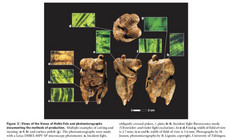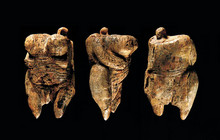The "Venus vom Hohle Fels": The Birth of Art
In a cave at the Swabian Alps archeologists of Tübingen discovered an over 35.000 year old fertility symbol – the oldest figural portrayal ever of a human.
The karst caves in a primal valley of the Donau River, the today’s Ach valley, hide the oldest known sculptural portrayals of humans, animals and hybrid creatures. Thereby four caves at the Swabian Alps became acquainted by sensational discoveries.
- Geißenklösterle (Ach valley)
- Hohle Fels (Ach valley)
- Hohlenstein-Stadel (Lone valley)
- Vogelherd (Lone valley)
Dr. Bertrand Ligouis has been instructed by the University Tübingen with the study of the “Venus vom Hohle Fels” and to produce a documentation of his processing method. Prof. Dr. Nicholas J. Conard (Department of Early Prehistory and Quaternary Ecology, University Tübingen) published the discovery of the Venus as well as the results of investigation in the journal “Nature Vol. 459”. Like other ivory figures from Hohle Fels the Venus belongs to the time of the lower Aurignacian(ca. 35000 years before present) and is consequently about 10000 years older than the famous “Venus von Willendorf” (ca. 27000 years before present, Gravettian). As a winking indication of the first sculptural portrayals of a female figure the “Venus vom Hohle Fels” is labeled as “Swabian Eve”.
Profile
A profile of her reads as follows:
- The Swabian Eve consists of ivory
- Except of the left shoulder region and one part of the left arm, the figure is complete extant and in good preservation
- The Venus is just under 6 cm high
- She has neither head nor neck
- Instead there is a carved eyelet on the broad shoulders of the figure
- The breasts are ample and point far forward
- The hands are carved having extra fine and clearly recognizable fingers
- The pudenda triangle and the genitalia are fully formed
- The surface of the Venus is characterized by several deeply gashed lines
- The traces of processing were photo-documented by us using fluorescence microscopy

In association with the department of pre- and early history and archeology of the Middle Ages of the University of Tübingen, the offered microscopic investigations by Dr. Bertrand Ligouis are of high scientific value. Further this example shows the enormous possibilities of the transfer and progression of coal petrography and its methods into other scientific fields.
Information about the “Venus vom Hohle Fels” and their place of discovery gives:
- N.J. Conard (2010): "Die Venus vom Hohle Fels." Urgeschichtliches Museum Blaubeuren, Museumsheft 9. Mit einem Beitrag von S. Wolf
- N. J. Conard (2009): “A female figurine from the basal Aurignacian of Hohle Fels Cave in southwestern Germany“, p. 248-252, Nature Vol. 459
- National Geographic Deutschland (June 2009): „Die Venus aus der Höhle“, p.32-57
